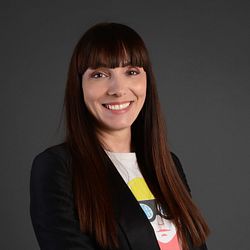
Blogginlägg -
Interview with Dejan and Tomche: Filling the engineering capacity gap with nearshoring
In this interview, Dejan Petreski, Oracle and Microsoft Technologies Division Manager and Tomche Hristovski, Division Manager Telecom, talk about the perks of nearshoring, what makes a good team and how Seavus helps companies focus on their core business. Tomche recently returned from Stockholm where he presented Seavus as a trustworthy partner at a nearshoring seminar, so he will be happy to share more details about the event as well.
Welcome back! To begin, what are your impressions from the event in Stockholm?
Dejan: The idea of the event was to promote Seavus as a brand, as a Scandinavian company that offers nearshoring services. Guest speaker at the event was Karl Larson, VP of System Solutions at Navetti which are one of our clients. Tomche can tell you more on this since he was one of the presenters.
Tomche: The concept involved presenting our services to the audience as well as sharing some experiences with some of our clients, such as Navetti. Navetti is our client for a decade now, and they are a valuable asset in our endeavors and growth as a successful nearshoring partner. What is interesting is that more than half of Navetti is a nearshoring team from Seavus, which enables them to focus on their core business! This means that Seavus delivers everything else: from solution architecture, business analysis, testing, database development, UA and UX testing and deployment, system integration and implementation or, in other words – the whole technical aspects plus project management.

And what makes nearshoring better than, let’s say, having a whole team employed?
Dejan: Well, there are three main aspects. Firstly, the market itself, especially in Stockholm, has a deficient qualified workforce and available resources that will take over the work. Additionally, the cost of employing a team is remarkably higher than having a nearshoring team. And finally, the whole process of ramp-up and ramp-down of the number of resources after a project slowly comes to an end. With nearshoring, it is easy to add new resources but also to exclude them from the team at any moment. Not to mention that having local consultants is much more expensive than having people employed, thus nearshoring seems to be the best solution in such cases because it is cost-effective and with a flexible ramp-up and ramp-down.
Tomche: I could not agree more, and I would like to add that building expertise, the whole recruiting process, the interviews, training sessions – everything that new employees must go through is successfully surpassed with nearshoring. Companies skip this process and thus save time, money and resources by receiving a readymade team.
Now, a word or two about the whole process: what does it look like, how long does it last and what does it entail? Where does Seavus fit in this picture?

Dejan: The whole process, from the initial contact to the beginning of collaboration can last from a week or two or up to three months or even more. This, of course, depends on the client and their needs – how fast they want to start. The planning process before we start the actual work can last from two to four weeks. During this period, we sign a non-disclosure agreement and a frame agreement, as well as the choice of location from where the initial resources will begin to work. There are to main approaches, i.e. models of nearshoring: resourcing (dedicated team) and fixed-scope project.
Tomche: Seavus offers both resourcing and fixed-scope models of nearshoring. As Dejan previously mentioned, we offer project management, development, testing, business analysis, technical solutions etc. Unlike offshoring, the advantage of nearshoring is the geographical proximity which brings a lot of simplification in the day to day communication.
What makes a successful nearshoring team?
Dejan: There are certain core characteristics that all teams should have, regardless if there are nearshoring teams or not, and that is to have mutual understanding and joint goals. This applies to both clients and Seavus as a nearshoring partner. As for teams, communication is key!
Tomche: I would like to highlight the importance of having a compact team. The longer a team works together, the better they know each other and this results in better communication and delivery. If you often switch teams, then a large amount of knowledge gets lost in the rotation process. Thus, having a compact and stable team is the second most important factor after communication.
What makes Seavus a reliable nearshoring partner?
Tomche: First things first – the location. We have 16 offices throughout Europe and one in America which is a solid soil for nearshoring. The offices are strategically positioned near universities so that we can easily add young talents to our team. Only a few of our offices are sales-hubs – the majority are development hubs where the main knowledge is gathered. Next, I would like to point out that our main focus is on creating a balance between cost-effective but also quality delivered solutions. Dejan, is there anything else you would like to add?
Dejan: Yes, Seavus’ headquarter is in Sweden, and our offices in Europe are both in EU and non-EU countries. This means that our clients make an agreement with an EU company and EU legislation, which guarantees security. Another aspect is our experience and proven track record in different technologies and software, product and platform development. This provides us with expertise in different segments and industries which makes us a one-stop shop for clients. On top of that, Seavus has both local representatives and offers a dedicated single point of contact. Our lifelong clients stand as proof for our quality delivered products.
You mentioned Navetti as one of the clients, and their VP of System Solutions that also took part in the seminar. Could you elaborate more on the whole experience?
Dejan: Our collaboration with Navetti began 10 years ago. In the beginning, only a nearshoring team of three or four people was working and, during the years, there has been a yearly increase of 20%-30% in team members. At the moment, the team has 40+ members that cover all aspects of the development process from Project Management, Solution Architects, Database Developers, .Net Developers, to Quality Assurance, Business Analyst and UI/UX Design. This gives the ability to the client to focus on the core business and rely on us for the technical aspects.
Tomche: What we should always have in consideration is that every company has its ups and downs and we, as Seavus, stand by our partners in any of these scenarios. We are all in this together, and that is why we strive to build long-lasting relationships, such as our success story with Navetti from 2008, or with Tele 2 from 2003. All in all, it all boils down to mutual understanding, open and straightforward communication and having mutual goals with your partner. I am saying ‘partner’ because we perceive our clients as partners, and their success is our success as well.



